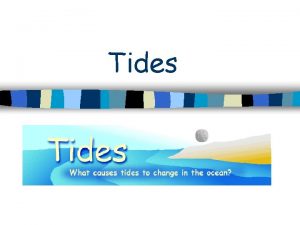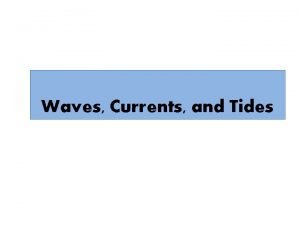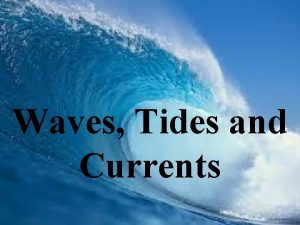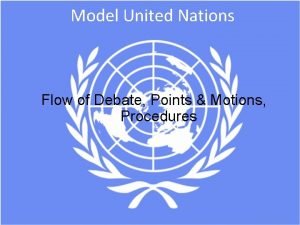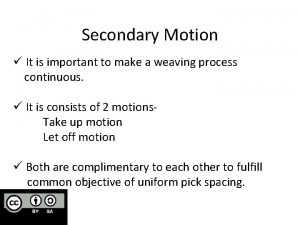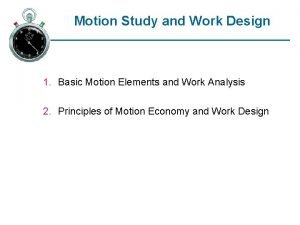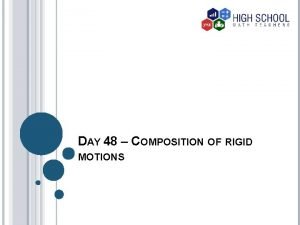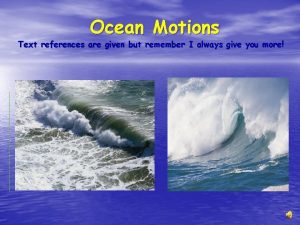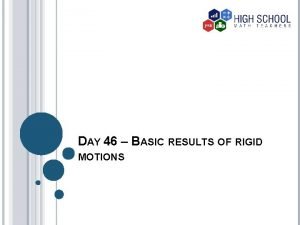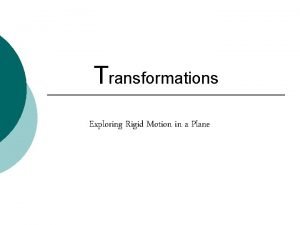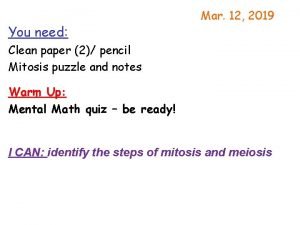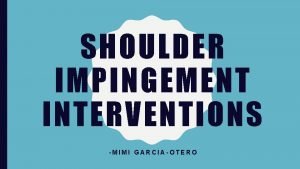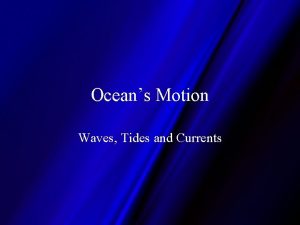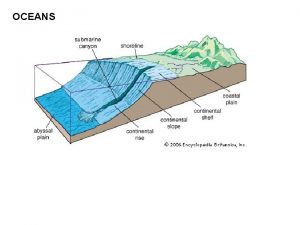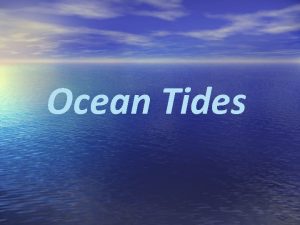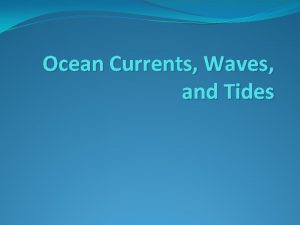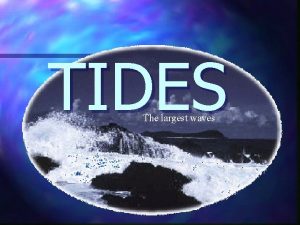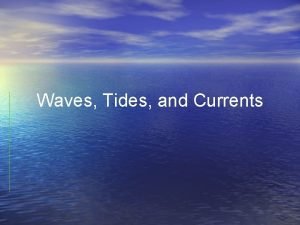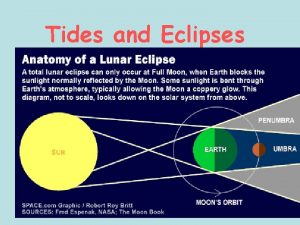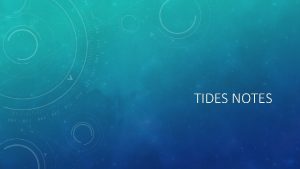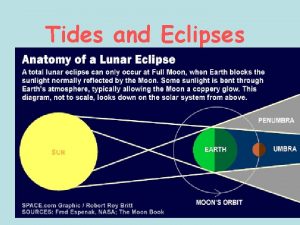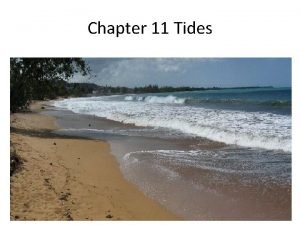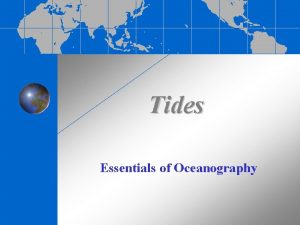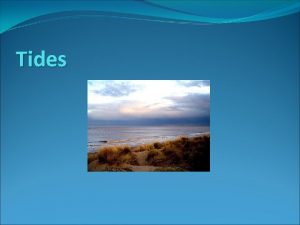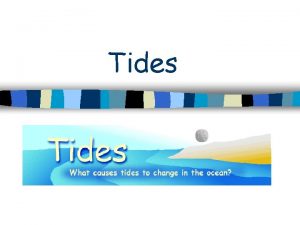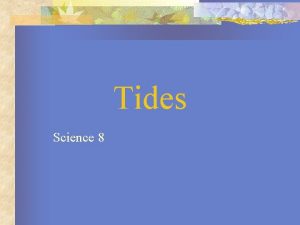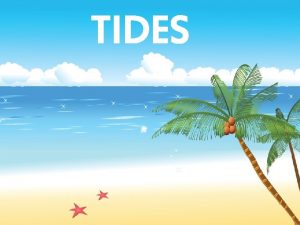Waves Tides and Currents I The Oceans Motions

































- Slides: 33

Waves, Tides and Currents

I. The Ocean’s Motions A. The ocean never rests. B. Currents, waves, and tides all move and mix the ocean waters.

II. Surface Circulation A. Currents and waves are driven by wind. B. Wind is driven by heat from the sun.

III. Coriolis Effect A. A force resulting from the rotation of the earth. B. It mainly affects freely moving objects, making it impossible to move in a straight line.

C. Organisms do notice the coriolis effect because it is too slight. D. Winds and currents are strongly influenced by the Coriolis Effect.

E. Earth’s rotation causes motion of objects to be deflected to the right or left. 1. Northern Hemispheremovement deflected to the right. 2. In Southern Hemisphere – movement deflected to the left.

IV. Winds A. Most solar energy is absorbed at the equator. B. As warm air rises, cooler air moves in replacing the warm air thus creating wind. C. Wind moves in bent lines due to the coriolis effect.

D. Trade Winds 1. Easterly surface winds found in the tropics near the equator. 2. Northern Hemisphere they blow northeast. 3. Southern Hemisphere - they blow southeast. 4. Approach the equator at 45⁰.

The Trade Winds

V. Currents A. Areas of water flowing naturally in the ocean driven by the wind, salinity and the surface temperatures. B. The currents move off at a 45° angle due to the Coriolis Effect.

C. Surface currents are caused by the wind blowing across the water surface. D. When pushed by the winds, the currents do not move the same direction as the wind.

VI. Gyres A. Definition – huge rotating currents of water in the ocean. B. Gyres develop due to the influence of the coriolis effect. C. There are 5 major gyres.

North Equatorial Current – California Current South Equatorial Current. West Australian Current South Equatorial Current – Peru Current North Equatorial Current – Canary Current South Equatorial Current – Benguela Current

Smaller Gyres

D. Pollution-gyres collect ocean trash, solutions are needed.

Show Video Clip – Safari Montage (Ocean Currents)

VII. Waves A. Most familiar ocean phenomena. B. Wave Anatomy 1. Crest-high point 2. Trough-low point 3. Wavelength-distance from one crest to another 4. Amplitude– rise and fall

C. Wave Anatomy

D. Water Movement 1. Water under the crests move up and forward. 2. Water under the troughs move down and backwards. 3. Water is actually just rolling in place or circling around and not really going anywhere.


VIII. Tides A. Definition - The rhythmic rise and fall of sea levels. B. Caused by the gravitational pull of the moon and the sun, along with the rotations of the earth, moon, and sun.

C. Centrifugal Force in Tides 1. Definition – outward force from the center of a rotation on a body rotating around another body. 2. The moon does not rotate around the earth rather both rotate around the center of their combined mass.

3. On the side where the moon pulls strongly on earth, it pulls on the oceans’ surface water too. 4. On the opposite side centrifugal force pushes water away from the earth.

Low Tide verses High Tide

High Tide verses Low Tide

D. The Sun’s Impact 1. The sun is much larger and is 400 times farther away from the earth than the moon. 2. Gravitational pull of the sun is half that of the moon.

E. Moon Phases Moon phases determine ocean tides.

F. Types of Tides 1. Spring Tides - When the sun and moon are in line with each other. a. Sun and moon’s combined pull affects the tide b. Occurs at new and full moons. c. There is a large difference between high and low tide.

d. Spring Tide Alignment

2. Neap Tide - When the sun and moon are at right angles with each other a. Effects of sun and moon are both diminished b. Occurs at first and third quarter. c. There is a small difference between high and low tide.

d. Neap Tide Alignment

G. Effects of Tides 1. Tides influence life of near shore organisms. 2. Effects of Tides: a. Alternately expose and submerge organisms b. Determines circulations of bays c. Triggers spawning.

n o s i r a p m s Co e d i T of
 Ocean currents waves and tides
Ocean currents waves and tides Compare and contrast spring and neap tides.
Compare and contrast spring and neap tides. Periodic rise and fall of sea level
Periodic rise and fall of sea level What is a deep current
What is a deep current Waves and tides
Waves and tides Ocean waves
Ocean waves Currents waves
Currents waves Compare and contrast p waves and s waves using venn diagram
Compare and contrast p waves and s waves using venn diagram Similarities of mechanical waves and electromagnetic waves
Similarities of mechanical waves and electromagnetic waves What are the mechanical waves
What are the mechanical waves Difference between electromagnetic and mechanical waves
Difference between electromagnetic and mechanical waves Long waves and short waves
Long waves and short waves Difference between matter waves and electromagnetic waves
Difference between matter waves and electromagnetic waves Mechanical and electromagnetic waves similarities
Mechanical and electromagnetic waves similarities Seismic waves
Seismic waves Mechanical wave and electromagnetic wave
Mechanical wave and electromagnetic wave The difference between constructive and destructive waves
The difference between constructive and destructive waves Motions model un
Motions model un Sound waves are transverse waves true or false
Sound waves are transverse waves true or false The wave chapter 13
The wave chapter 13 Whats a reflected sound wave
Whats a reflected sound wave Mechanical vs electromagnetic waves
Mechanical vs electromagnetic waves Is a seismic wave mechanical or electromagnetic
Is a seismic wave mechanical or electromagnetic Secondary motion of weaving
Secondary motion of weaving Principles of motion economy
Principles of motion economy What is a composition of rigid motions
What is a composition of rigid motions Song leading
Song leading Ocean motions
Ocean motions Basic rigid motions
Basic rigid motions Advantages of size separation
Advantages of size separation Dot translater
Dot translater True motions
True motions Ipmatc mnemonic
Ipmatc mnemonic Mimi garcia h
Mimi garcia h


